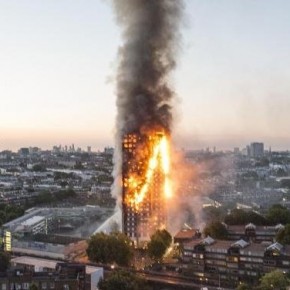
GUEST ARTICLE: Two years on, what have we learned from Grenfell?
This article sees Aidan Bell, co-founder of sustainable building materials company Envirobuild, explore why current legislation is not doing enough to ensure the safety of the 40,000 people still living in buildings with Grenfell-like cladding, over two years since the tragedy.
What Happened?
The fire that engulfed Grenfell Tower in 2017 was described by the BBC as ‘one of the UK’s worst modern disasters’, catastrophically killing 72 people.
This blaze in the 24-storey residential building started on the fourth floor before rapidly spreading up the building externally, largely encouraged by its flammable aluminium-polyethylene cladding which had been installed on the tower in a recent renovation.
After the event, Dame Judith Hackitt was commissioned by the government to review building regulations. She expressed 4 core issues underpinning the flawed system; ignorance, indifference, uncertainty regarding responsibilities, and inconsistency in enforcement and guidance.
In Hackitt’s review, the failures in fire system regulation are referred to as a ‘cultural issue across the sector’, suggesting that more focus must be applied to building quality to ensure that residents are safe.
Two years on, what has the construction industry changed to prevent such a catastrophe from happening again?
What has Changed for Construction?
Following the fire, the government instructed the Building Research Establishment to undertake compliance tests, aiming to develop an understanding of the ways different combinations of Aluminium Composite Material (ACM) and insulation react during a fire.
Although Grenfell’s cladding had been compliant with BS 8414 testing alongside certain insulation types, its particular combination of ACM and insulation had not been tested.
It was argued that the unawareness regarding the differing combustibility of certain setups was due to lacking clarity in the Government’s pre-Grenfell technical guidance.
Clause 12.7 of Approved Document B2, had stated that any ‘insulation product’ or ‘filler material’ on buildings above 18 metres should be of ‘limited combustibility’.
Although this clause clearly applied to insulation used in cladding systems, the guidance did not specifically outline the inclusion of outer cladding material as well, although the Government later argued that this was to be assumed.
The installation of a flammable combination onto Grenfell Tower has highlighted that sections of the construction industry were either unaware of the advice or were confused by it, highlighting the prescriptive nature of pre-Grenfell fire regulation that Hackitt warns against.
The government has since changed the wording of their advice to avoid further miscommunication, as seen in clause 12.6, a matter that was discussed in court.
Following Hackitt’s acknowledgement of an industry-wide unclarity, alongside a public outcry, the government placed a ban on using combustible materials on the external walls and specified attachments of new high-rise buildings over 18 metres in December 2018.
Materials used in the construction of tall residential buildings were limited to those with a fire rating of Class A1 (non-combustible) or A2 s1 d0 (very limited combustibility) under the harmonised European Standard EN13501.
This means that all components of the external walls and attachments on buildings over 18 metres, must be individually tested. The use of materials is therefore limited to materials like metal, stone, rockwool or plasterboard.
This legislation has demanded a transformation of the marketplace through eliminating the use of many traditional materials, aiming to ensure that that external walls on all high-rise buildings resist the spread of flames.
However, due to the typical lack of retrospectivity in legislation, the ban was not applied to properties where combustible materials had already been fitted pre-2019.
Contesting Responsibility for Change
As well as new, it was important to consider existing structures. In July 2018, a year after Grenfell, the Government announced that they would fund the re-cladding of public residential buildings with unsafe ACM of 18 metres or more at an estimated cost of £400 million.
The responsibility to fix private residential properties was said by the Government to lie with the landlords, freeholders and developers.
However, under the terms of most leases, the responsibility for replacing flammable cladding fell into the hands of the leaseholders. This has resulted in a lack of progress, enhanced by legal conflict between freeholders and leaseholders, with many homeowners unfairly resorting to paying for fire wardens to reduce safety concerns whilst the legal wrangles are resolved.
Despite government rhetoric, very few buildings with combustible cladding have actually been replaced, and the problem has been largely ignored.
Campaigns are underway and legal battles look set, 27 months after Grenfell, disputing the replacement of unsafe cladding that was installed under ineffective legislation.
In May 2019, the government offer was extended to private sector residential buildings with unsafe ACM cladding, being allocated £200 million, certainly not enough to fix them all, and only applicable to ACM style cladding, excluding other flammable cladding types previously used.
What is Construction’s Responsibility?
Construction issues that contributed to other fires such as Dubai’s Marine Torch (2015 and 2017), and South London’s Lakanal House (2009), should have been treated as warnings, so that regulations were changed.
Lessons from the Lakanal House fire, that could have prevented the Grenfell catastrophe were disastrously ignored. Past events must inspire adapted practice to avoid them repeating.
Although the government is ultimately responsible for legislation regarding fire regulation and safety, the construction industry must be diligent and attentive to prevent future disaster.
Everyone involved should be taking proactive responsibility for their actions regarding fire regulation.
A recent investigation by Shelter found that reported housing issues are still being ignored by councils and housing associations, with 1 in 10 tenants having to report the same issue more than 10 times to their landlord.
Over the last 3 years, at least 400,000 people have come across an issue regarding fire safety, also affecting their neighbours in over two-fifths of the cases, emphasising a deep mistrust and significant lack of transparency for residents.
In the construction industry, we have a responsibility to learn from past mistakes. Resident concerns must be taken seriously and acted upon quickly, not only to enhance their security, but to develop improved understanding, transparency and trust between those involved.
What has the Construction Industry Learnt?
Grenfell shook the construction industry, highlighting the disastrous potential of unclarified regulation and undefined responsibility.
The fact that, two years after the disaster, responsibility for correcting dangerous buildings is still contested is an embarrassment.
Value engineering in construction must take a pro-active and holistic approach, where any changes are checked for wider safety ramifications, encouraging a transparent and thorough attention to detail.
The catastrophe has demanded an enhanced focus towards occupant safety equal to the continued focus upon construction worker safety. Growing awareness and open conversations indicate increased feelings of responsibility that companies and individuals are having towards fire security.
It is vital that events, near misses or findings regarding any aspect of safety are shared transparently, investigated and learnt from. The foreshadowing of Grenfell in the Lakanal fire is the most damning of all the evidence of an industry asleep at the wheel.
The combustible material ban passed in December 2018 made progress, preventing the use of combustible materials on all high-rise cladding and balcony designs.
But the recommendations made within the Hackitt report need to be implemented faster, with further expected legislation still to come.
Latest news

26th April 2024
Hush Acoustics optimises fleet operations by securing FORS Gold accreditation
Hush Acoustics has invested in the safety and sustainability of its commercial vehicle fleet by achieving Gold status in the Fleet Operator Recognition Scheme (FORS).
Posted in Acoustics, Noise & Vibration Control, Articles, Building Industry News, Building Products & Structures, Building Regulations & Accreditations, Building Services, Ceilings, Facility Management & Building Services, Floors, Health & Safety, Insulation, Restoration & Refurbishment, Retrofit & Renovation, Site Preparation, Sustainability & Energy Efficiency, Walls, Waste Management & Recycling
26th April 2024
Safeguard Europe: Penetrating damp - how to diagnose the damage
As Safeguard gets ready to deliver another informative session of one of its most popular webinars, the company outlines some of the most common reasons for rain penetration through brickwork.
Posted in Articles, Bricks & Blocks, Building Industry Events, Building Industry News, Building Products & Structures, Building Services, Continuing Professional Development (CPD's), Damp & Waterproofing, Facility Management & Building Services, Information Technology, Posts, Render, Restoration & Refurbishment, Retrofit & Renovation, Seminars, Training, Walls
25th April 2024
ADSA: Competence Initiative Makes Progress
The Joint Competency Initiative (JCI), in which the Automatic Door Suppliers Association (ADSA) is involved, is finalising its first framework for installers within the door, gates and shutter industry.
Posted in Access Control & Door Entry Systems, Architectural Ironmongery, Articles, Building Associations & Institutes, Building Industry Events, Building Industry News, Building Products & Structures, Building Regulations & Accreditations, Building Services, Continuing Professional Development (CPD's), Doors, Facility Management & Building Services, Health & Safety, Innovations & New Products, Publications, Research & Materials Testing, Restoration & Refurbishment, Retrofit & Renovation, Security and Fire Protection, Site Preparation
25th April 2024
BMBI: Value sales in first two months were -3.4% down
The latest Builders Merchant Building Index (BMBI) report shows builders’ merchants’ value sales were down -4.7% in February compared to the same month a year ago.
Posted in Articles, Bathrooms & Toilets, Bathrooms, Bedrooms & Washrooms, Bricks & Blocks, Building Associations & Institutes, Building Industry News, Building Products & Structures, Building Services, Civil Engineering, Concrete, Cement, Admixtures, Drainage, Floors, Hard Landscaping & Walkways, Interior Design & Construction, Interiors, Landscaping, news, Paints, Paints, Coatings & Finishes, Plant, Equipment and Hire, Plumbing, Posts, Publications, Research & Materials Testing, Restoration & Refurbishment, Retrofit & Renovation, Sustainability & Energy Efficiency
 Sign up:
Sign up: